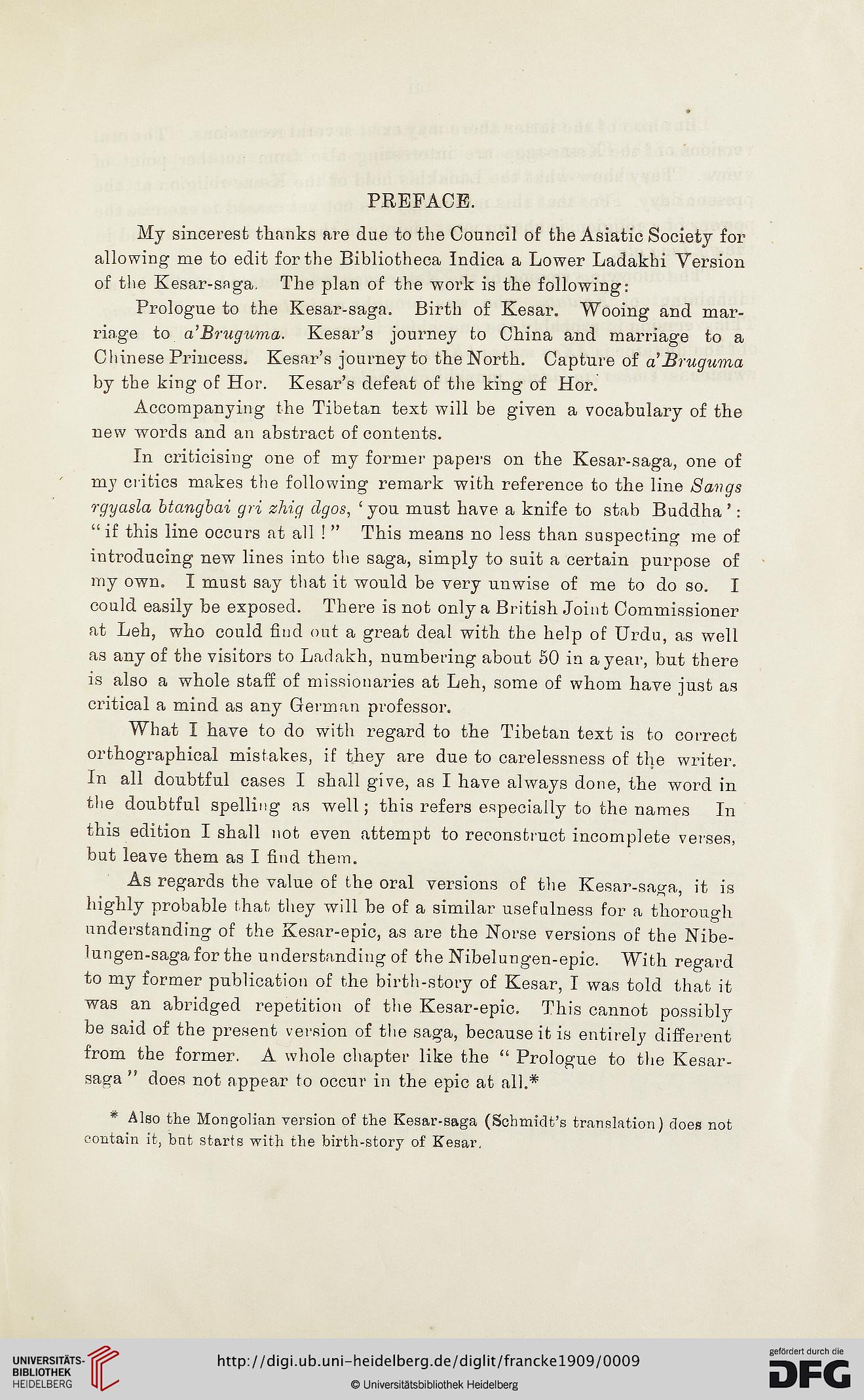PREFACE.
My sincerest thanks are due to the Council of the Asiatic Society for
allowing me to edit for the Bibliotheca Indica a Lower Ladakhi Version
of the Kesar-snga. The plan of the work is the following:
Prologue to the Kesar-saga. Birth of Kesar. Wooing and mar-
riage to a'Brugwma. Kesar’s journey to China and marriage to a
Chinese Princess. Kesar’s journey to the North. Capture of aBruguma
by the king of Hor. Kesar’s defeat of the king of Hor.
Accompanying the Tibetan text will be given a vocabulary of the
new words and an abstract of contents.
In criticising one of my former papers on the Kesar-saga, one of
my critics makes the following remark with reference to the line Saiigs
rgyasla btangbai gri zhig clgos, ‘ you must have a knife to stab Buddha ’:
“if this line occurs at all ! ” This means no less than suspecting me of
introducing new lines into the saga, simply to suit a certain purpose of
my own. I must say that it would be very unwise of me to do so. I
could easily he exposed. There is not only a British Joint Commissioner
at Leh, who could find out a great deal with the help of Urdu, as well
as any of the visitors to Ladakh, numbering about 50 in a year, but there
is also a whole staff of missionaries at Leh, some of whom have just as
critical a mind as any German professor.
What I have to do with regard to the Tibetan text is to correct
orthographical mistakes, if they are due to carelessness of the writer.
In all doubtful cases I shall give, as I have always done, the word in
the doubtful spelling as well; this refers especially to the names In
this edition I shall not even attempt to reconstruct incomplete verses,
but leave them as I find them.
As regards the value of the oral versions of the Kesar-saga, it is
highly probable that they will be of a similar usefulness for a thorough
understanding of the Kesar-epic, as are the Norse versions of the Nibe-
1 ungen-saga for the understanding of the Nibelungen-epic. With regard
to my former publication of the birth-story of Kesar, I was told that it
was an abridged repetition of the Kesar-epic. This cannot possibly
be said of the present version of the saga, because it is entirely different
from the former. A whole chapter like the “ Prologue to the Kesar-
saga ” does not appear to occur in the epic at all.*
* Also the Mongolian version of the Kesar-saga (Schmidt’s translation) does not
contain it, bnt starts with the birth-story of Kesar.
My sincerest thanks are due to the Council of the Asiatic Society for
allowing me to edit for the Bibliotheca Indica a Lower Ladakhi Version
of the Kesar-snga. The plan of the work is the following:
Prologue to the Kesar-saga. Birth of Kesar. Wooing and mar-
riage to a'Brugwma. Kesar’s journey to China and marriage to a
Chinese Princess. Kesar’s journey to the North. Capture of aBruguma
by the king of Hor. Kesar’s defeat of the king of Hor.
Accompanying the Tibetan text will be given a vocabulary of the
new words and an abstract of contents.
In criticising one of my former papers on the Kesar-saga, one of
my critics makes the following remark with reference to the line Saiigs
rgyasla btangbai gri zhig clgos, ‘ you must have a knife to stab Buddha ’:
“if this line occurs at all ! ” This means no less than suspecting me of
introducing new lines into the saga, simply to suit a certain purpose of
my own. I must say that it would be very unwise of me to do so. I
could easily he exposed. There is not only a British Joint Commissioner
at Leh, who could find out a great deal with the help of Urdu, as well
as any of the visitors to Ladakh, numbering about 50 in a year, but there
is also a whole staff of missionaries at Leh, some of whom have just as
critical a mind as any German professor.
What I have to do with regard to the Tibetan text is to correct
orthographical mistakes, if they are due to carelessness of the writer.
In all doubtful cases I shall give, as I have always done, the word in
the doubtful spelling as well; this refers especially to the names In
this edition I shall not even attempt to reconstruct incomplete verses,
but leave them as I find them.
As regards the value of the oral versions of the Kesar-saga, it is
highly probable that they will be of a similar usefulness for a thorough
understanding of the Kesar-epic, as are the Norse versions of the Nibe-
1 ungen-saga for the understanding of the Nibelungen-epic. With regard
to my former publication of the birth-story of Kesar, I was told that it
was an abridged repetition of the Kesar-epic. This cannot possibly
be said of the present version of the saga, because it is entirely different
from the former. A whole chapter like the “ Prologue to the Kesar-
saga ” does not appear to occur in the epic at all.*
* Also the Mongolian version of the Kesar-saga (Schmidt’s translation) does not
contain it, bnt starts with the birth-story of Kesar.




